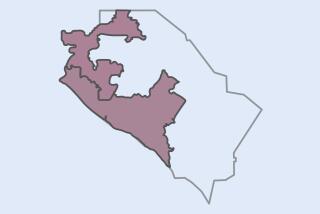Remap Gives Asian Voters More Clout : Politics: New 24th Senate District links Little Tokyo, Chinatown and Monterey Park.
SACRAMENTO — The redistricting plan the state Senate has approved for itself aims to boost the political clout of Asian-Americans by creating a district that links several San Gabriel Valley communities with parts of central Los Angeles.
Responding to complaints from a newly formed coalition of San Gabriel Valley Latino and Asian politicians and activists, the Senate proposal lumps into a single district the heavily Asian-American cities of Rosemead, Monterey Park, San Gabriel and Alhambra and the downtown Asian-American enclaves of Chinatown, Little Tokyo and parts of Koreatown.
These communities would be part of the redrawn 24th Senate district, which is now represented by Sen. Art Torres (D-Los Angeles).
Torres still would be expected to win reelection in the predominantly Democratic district. But state Sen. President Pro Tem David A. Roberti said the proposed boundary change followed through on his pledge to maximize the influence of the state’s growing Asian population in the Senate.
Roberti, a Los Angeles Democrat, said the Senate proposal would boost the number of Asians in Torres’ district from 14% to 22%, “making it probably the second-largest concentration of Asian-Pacific Islanders in the country, outside Hawaii.”
Another proposed Senate district in San Francisco would have an Asian population of around 30%.
There are no lawmakers of Asian descent now serving in the Legislature.
The lines of Assembly, Senate and congressional districts are being reconfigured to meet population growth and shifts reported in the 1990 Census.
Even though the 40-member Senate overwhelmingly approved its new political map Monday, the plan still could be put on hold and, ultimately, significantly revised. In part because of a disagreement involving the shape of new Assembly districts, Republicans say, Gov. Pete Wilson may veto the Legislature’s entire reapportionment plan. Such a veto could result in the courts redrawing the state’s political maps. Also, the Mexican American Legal Defense and Educational Fund and other minority groups are expected to fight the once-a-decade reapportionment legislation in court.
The Senate plan was crafted with an eye toward such possible challenges. Senate leaders representing both parties sought to devise boundaries that could withstand court challenges and meet requirements of the federal Voting Rights Act that call for maximizing the voting strength of minorities.
Under an earlier version of the Senate proposal, the San Gabriel Valley and downtown Asian-American communities would have remained split between two districts. But the new plan surfaced in response to lobbying by a coalition of Asian-American and Latino activists.
Despite the boost in Asian-American population, Torres’ redrawn district would remain overwhelmingly Latino. Of about 742,000 people in Torres’ proposed district, Latinos would make up 61%, a drop of 8% from 1983, according to figures released by the Senate.
Nevertheless, Asian-Americans say their numbers in the new district would insure that their voices would be heard and their concerns heeded.
Monterey Park City Councilwoman Judy Chu, who lobbied for the redrawn district, said that whoever represents it would have “to pay attention to the needs of Asians.”
Acknowledging that wide political differences can exist within the Asian-American community, Chu said at least one lawmaker under the Senate plan would be attuned to how the various national groups line up on issues.
Chu and others said the plan was the product of an alliance formed in recent months between members of the Coalition of Asian-Pacific Americans for Fair Reapportionment and the San Gabriel Valley Latino Redistricting Coalition. Lumping together the Asian-American communities helped further the bid to create a new predominantly Latino Senate district that includes the communities of Boyle Heights, Huntington Park, South Gate, Bell, Bell Gardens and Maywood.
Despite predictions that the effort would be marked by ethnic and racial tension, members of the coalition said that after a series of meetings they were able to hammer out a unified position. Moreover, they hope that cooperation on redistricting will be the cornerstone of cooperation on other issues in the San Gabriel Valley.
Joe Vasquez, a Rosemead school board member who has pushed for fair Latino representation in redistricting, said the drive to reshape Torres’ district shows that Latinos and Asians can help each other in politics.
He said cooperation among the groups can now be extended to other issues, such as easing tensions between Asian and Latino students in schools.
Stewart Kwoh, executive director of the Asian Pacific American Legal Center of Southern California, added that the coalition effort represented the first time local Asian-Americans and Latinos have gotten together “on a major statewide political issue.”
Kwoh joined in the praise for the proposed 24th Senate District, saying the change would increase the political clout of the Asian-American electorate and help focus that group’s campaign contributions. Still, he complained that the district does not also encompass all of Koreatown and heavily Filipino communities in Central Los Angeles.
More to Read
Sign up for Essential California
The most important California stories and recommendations in your inbox every morning.
You may occasionally receive promotional content from the Los Angeles Times.










